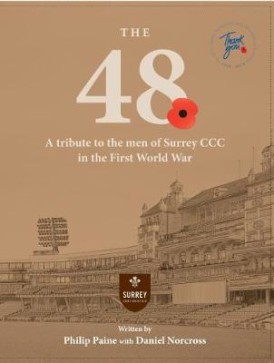The 48
Martin Chandler |Published: 2018
Pages: 272
Author: Paine, Philip and Norcross, Daniel
Publisher: Surrey CCC
Rating: 4 stars

As a long time supporter of Philip Paine’s self-published Innings Complete series I did know about this book, Philip having announced it in one of his regular mailshots some time ago. There were then occasional updates on its progress until, eventually, a final one said that the Surrey Club had taken over the publication duties, and that was that. It was only relatively recently that I learnt the book had finally appeared and, if you look patiently enough, you can find it for sale in the club’s shop.
In recent years there have been what has sometimes seemed like a slew of books published to mark the centenary of the Great War, and to give the stories of the many who gave their lives in that conflict. A goodly number of the casualties came from the world of cricket and part of the reason I did not pursue this one too vigorously was the assumption it would be covering much the same ground as others had covered before. I know now that that was a mistake. The 48 is a gem, and highly recommended.
There is a war memorial in the long room at the Oval, and the 48 names it bears are the subject of the book. Only two are players of note, John Raphael and the Anglo-Australian Alan Marshal. Marshal has figured in a few books, and in a splendid but very rare monograph by Duncan Anderson, but him apart only Ernest Attwater, on the subject of whose life Roger Heavens has recently published a booklet, was a man I knew anything about.
It speaks volumes that as many as 40 of the 48 were officers, many of whom attended public schools. The youngest is just 18 and many are in their twenties. Not infrequently those who gave their lives were already established men of some wealth. Not all were cricketers, some simply being club members but, with one exception, Paine has identified them all and has managed to track down an impressive amount of information about most of them. The one man whose identity has eluded him, recorded on the memorial simply as C Green, still gets space devoted to him as Paine identifies and discusses four men who he concludes are the best candidates to be the man who the memorial is referring to.
The book begins with an elegantly written note by Norcross, who undertook the editing duties, which is then followed by an introduction from Paine. The bulk of the book then contains two to three pages on each of the 48, taken in strictly alphabetical order. The book is profusely illustrated, although a few of the images might have benefitted from a bit more work being done on them. In particular some letters from the front are reproduced in an appendix, and in the absence of any enhancement it would have assisted had they been transcribed. That said the overwhelming majority of the photographs are very well presented indeed.
There is inevitably a sense of pathos aroused in reading any book that amounts to a collection of obituaries of people who died too young and in tragic circumstances. At the same time something in the nature of a warm glow is caused by the knowledge that Paine’s researches have perpetuated the memory of the ultimate sacrifice these men made. I enjoyed reading The 48 much more than I expected to, and am delighted to recommend it.






A well researched book, of interest to more than Surrey members.
Comment by Iain Taylor | 11:05am BST 15 July 2019
A well researched book, like many others by this author. Of interest to more than just Surrey followers.
Comment by Iain Taylor | 11:07am BST 15 July 2019